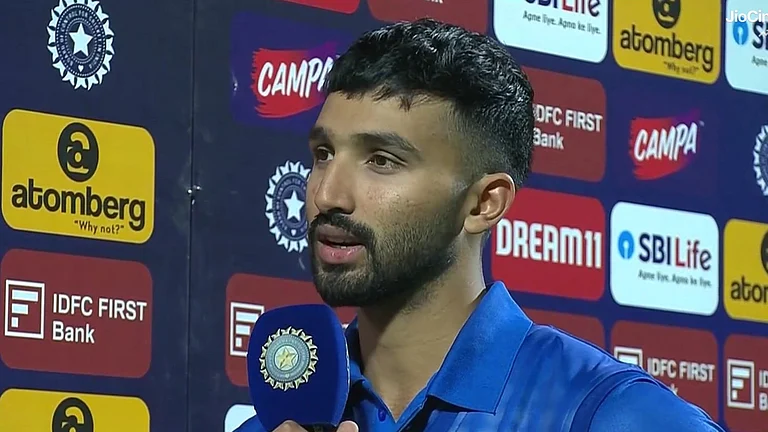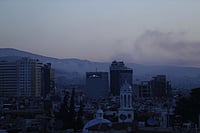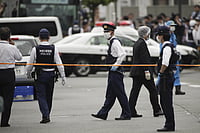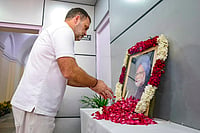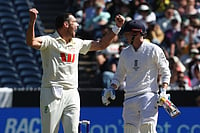Fifty years. Three full-scale conflagrations. One high-casualty flare-up no one knew how to define except that it was deadlier than the real thing - that it occurred when nuclear test zones were still smouldering. A non-stop, low-intensity battle thats been bleeding the region dry for over a decade. Attempts to graft a peace always produced an opposite effect, a rancorous exchange that passes for dialogue, or a hostile silence. Thousands have died, on either side - for a cause, without a cause. All signs are that weapons will settle nothing, only beget more of the same. And they still speak of war.
Bill Clinton talks of it, as does Madeleine Albright. George Fernandes doesnt "rule out the possibility". On the other side of the border, its been a constant, taunting refrain.
This, then, is the worlds favourite nuclear flashpoint. Prime Minister Vajpayee, referring to Pakistans threat to use the Bomb, said recently, "If they think they can destroy us first, theyre mistaken." Army chief V.P. Malik chimed in by hinting at a limited war. Across the border, Gen Pervez Musharrafs actions havent matched his rhetoric. Even as he mouths niceties about a dialogue with India, the orders are clear: keep the LoC on fire on the eve of Clintons visit to India, so that the world is goaded to step in.
It will surely require a near-miracle to cool temperatures between the two countries. There have been eight major showdowns along the LoC in the last two months and innumerable, increasingly daring terrorist attacks in the Valley. The killing of seven Indian soldiers in Naushera in Rajouri on February 27 and the attack in Akhnoor in Jammu where 25 Pakistani soldiers were slain on January 22 raised visions of worse things to come. "It is just going to get really bad when the snow begins to melt north of the Pir Panjal ranges," says an army officer.
The ground situation was matched by verbal pugilism. Vajpayee spoke of retrieving Pakistan-occupied Kashmir. His defence minister unveiled a limited war code. The massing of troops along the border, and war exercises conducted by the army in the deserts around Bikaner and the navy on the Arabian Sea, aroused concern about the flow of events. J&K chief minister Farooq Abdullah did his bit on February 6, saying: "A day doesnt pass without bombs going off. How long can we watch silently?" Indias military establishment and troops deployed in the Valley say if the situation slides further, it could lead to a serious confrontation. Army officials reckon the violence will spiral further when Clinton comes calling later this month. "The skirmishes may escalate manifold if he doesnt visit Islamabad," says a raw officer.
The army top brass ruefully concedes there will be no let-up in the heightened combativeness, demonstrating that Musharrafs larger strategic doctrine is paying off. "If we have to avoid war, we will continue to bleed. They keep kicking us in the shins and well take it," says a senior MI officer. The attacks, thus, have been more barefaced and come with a strong element of surprise. He reckons that the governments tolerance level with respect to Kashmir is "elastic", which has been exploited to the hilt by Musharraf.
This "elasticity" has led to the creeping upgradation of militant activities qualitatively in the Valley and well-calibrated infiltration bids on the LoC. "The trend began with the storming of the bsf residential complex in Bandipora in July 1999, followed shortly by the attack on a Rashtriya Rifles post in Chak Natnusa," says a captain. Openly targeting army camps and engaging troops in fierce gun battles was a direct spin-off of the Kargil conflict. "The embarrassing pullout of the Pakistani troops allowed the mujahideen to regroup, where they are now willing to stand and fight," says a colonel. Musharraf had told a gathering of the United Jehadi Council that there would be no dearth of funds for their activities.
This new, fearless streak has made an appreciable impact on the ground. "Its not as if were ill-equipped or poorly deployed. Theres been a shift in the militants strategy, which explains the surge in violence," says an IB official. Moreover, in the last four months, a number of third-country jehadi groups - deep in the pocket and well-armed - have jumped into the fray, bringing with them experience and calculated, brazen aggression.
Reports from the ground suggest that this new crop of battle-inoculated mercenaries have been put through a rigorous form of training, almost on the lines of regular soldiers. This unending assembly line of mujahideen, which the establishment in Pakistan throws up and supports, is pumped into Kashmir. "They are trained in sentry silencing, control of artillery fire and ambush attacks," adds an army senior. Foreign or "guest" militants killed in encounters have been steadily rising, which confirms their large-scale induction. "Till October last year, almost 260 foreign militants were killed. This is a huge number," says a bsf official.
Equipped with a sophisticated arsenal, approximately 2,000-odd mercenaries have managed to infiltrate the state along various porous parts of the border in the last seven months. These motivated cadres on contract missions have only one objective. "Spread terror and create mayhem," says an IB official. Which also explains the exponential increase in the use of improvised explosive devices in the Valley and along the LoC in the recent months.
Theres a pattern to the violence. Army officials believe the idea is to attack larger military formations. "Attacks on army divisions or brigade headquarters have a greater ripple effect," says a senior officer. So if it is not high-profile installations, there are other marked areas targeted with ruthless efficiency. "The killing, for the first time, of five Hindu private truckers in Anantnag this week on the Jammu-Srinagar highway and the brazen attack on Ari-Harni village in Poonch a day earlier has cranked up security in Jammus border towns," says an inspector general of police.
Almost 20,000 troops (two divisions) are positioned in the Kashmir Valley along the LoC. Yet, infiltration continues through the snow-bound passes. The aim of the militants now, supported by the Pakistani army, is to put pressure along the Uri, Tanghdar, Poonch, Pallanwala and Mendher sectors on the Jammu side, which was till a few months back considered safe. "Obviously, they want to open fronts here as well," says an army general.
The troops face a real dilemma: should they force an offensive or hold themselves back? One option will need to be backed by a serious endeavour to lessen tensions and begin negotiations. With the other, theres no saying what could follow.










